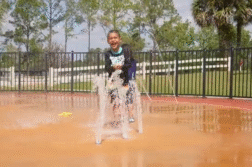ORLANDO, Fla. (Ivanhoe Newswire) – Call them the bionic kids! Researchers at the University of Central Florida have developed bionic arms for kids who are born without. Those scientists developed a spin-off company called Limbitless Solutions and have continued to develop and improve the functions of the prosthetics. The scientists now want to know how the kids’ brains change when they take part in activities that others take for granted.
Twelve-year-old Sami Atkinson’s arm is part function, part personal fashion.
Sami was born with a condition that caused her arm to develop incompletely. Three years ago, she joined a trial being conducted by Limbitless Solutions. The scientists specialize in developing advanced, muscle-sensing technology.
“It’s [the arm]not heavy anymore because I use all my muscles.” Sami tells Ivanhoe.
The newest version of the bionic arm uses electromyography. When the muscles flex, they produce a voltage, like a battery.
Co-founder of Limbitless Solutions, Albert Manero, PhD, explains, “With the same stickers that you would use for having an EKG on your chest, we can put them on the bicep muscle. And then, when that muscle is contracted, we read that signal and send it to the computer chip that’s in the hand. And that will tell the hand to do different gestures and routines.”
Next, these researchers want to know what changes are occurring in kids who were born without limbs, but now have prosthetics that can pinch and lift.
“We’re looking at seeing if there’s any changes in the brain and the functionality,” UCF Health Sciences student, Shea McLinden, says.
Sami says in the past three years, she’s been able to help with chores at home.
“I could fold laundry; I could fold shirts. I can fold anything,” she exclaims.
The researchers say the prosthetics empower children at a time during their social development when they may need validation most.
Sami says, “Just always remember that you’re special.”
Over the past three years, the researchers have fitted 18 children with the customized prosthetics, which are 3D printed. The kids enrolled in the trial will perform tasks in a functional MRI machine so researchers can measure their brain activity.
Contributors to this news report include: Cyndy McGrath, Producer; Kirk Manson, Videographer; Roque Correa, Editor.
To receive a free weekly e-mail on medical breakthroughs from Ivanhoe, sign up at: http://www.ivanhoe.com/ftk
Source:
MEDICAL BREAKTHROUGHS
RESEARCH SUMMARY
TOPIC: BIONIC ARMS FOR KIDS: SAMI’S SUPERPOWER!
REPORT: MB #5114
BACKGROUND: Upper and lower limb reduction defects occur when a part of or the entire arm (upper limb) or leg (lower limb) of a fetus fails to form completely during pregnancy. The defect is referred to as a “limb reduction” because a limb is reduced from its normal size or is missing. Researchers estimate that about 1 in every 1,900 babies is born with a limb reduction defect in the United States. Some of these babies will have both upper and lower limb reduction defects.
DIAGNOSING: A child with a congenital limb defect has an arm or leg that hasn’t formed normally. The most common of these defects are no limb at all, part of the limb doesn’t separate, often seen in fingers or toes, duplication, often seen as extra fingers or toes, the limb is much larger than the normal limb (overgrowth), or the limb is much smaller than the normal limb (undergrowth). The diagnosis of a congenital limb defect is made at birth. It may be linked to other bone conditions or syndromes. Always talk with your child’s healthcare provider for a diagnosis.
(Source: https://www.stanfordchildrens.org/en/topic/default?id=congenital-limb-defect-in-children-90-P02752)
NEW TECHNOLOGY: A new, first-of-its-kind clinical trial will examine how the brain adapts to advanced, bionic arms in children born without a limb, with the ultimate goal of improving children’s control of their prosthetic. Limbitless Solutions, which Albert Manero co-founded as a graduate student at UCF along with John Sparkman ’13 ’15MS and Dominique Courbin ’18, specializes in developing advanced, muscle-based biosensing technology, such as bionic limbs, to increase accessibility and empower children and adults in the limb-different community. The study is unique because it combines advanced imaging techniques with novel prosthetics and video-game-based training to evaluate motor cortex engagement. The Limbitless Solutions team is also partnered with Dr. Albert Chi of the Oregon Health and Science University in the study. Dr. Chi is trauma surgeon with expertise in biomedical engineering.
FOR MORE INFORMATION ON THIS REPORT, PLEASE CONTACT:
Zenaida Kotala
If this story or any other Ivanhoe story has impacted your life or prompted you or someone you know to seek or change treatments, please let us know by contacting Marjorie Bekaert Thomas at mthomas@ivanhoe.com




